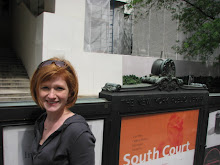The man who spoke to us was named John Cotton, and he is a curator in prehistory at the Museum of London.The museum started in 1976 and put together the London Museum that previously existed in Kensington Palace (from 1911), the London Archaeology Museum and Archives, and also the Guild Hall Museum (1825) in the City of London.The Museum of London capitalizes on "the city" that was once the square mile.
Their innovative marketing campaigns include a truck with a huge sign on it that they park in front of rival museums. The signs state things like, "London only has one museum" which is intriguing and really gets people through their doors. I asked and found out that they have their own in-house marketing department that creates the great campaigns. Awesome.
They have one USP or "Unique Selling Point": They are the largest Urban history museum in the world.". But the problem they have is, how do you utilize this USP and still illustrate that there is a vast amount of information there regarding prehistoric times/people? The National History Curriculum in England (all schools) begin with invaders and conquerors and do not include prehisoric times.
While they were investigating how to work the prehisoric periods into their marketing and promotions, they found that they typically have 3 types of visitors:
- Those who want to know about Victorian London (19th century)
- Those who want to know about Tudor London (16th-17th century..that's me)
- Those who want to know about Londinium (Roman London)
The newer galleries are more people-centered, more negotiable and conversation-starting, the pieces ask questions and start discussions between people who come to view the exhibits. They decided to center the focus of the exhibits around four things: Climate changes (global warming), People, the River Thames, and Legacy.
They created 3 design elements to work these things into the galleries. There is a wall of things that were found in the River Thames, and the river weaves throughout the galleries, so people can bounce between the plinths (exhibits) and the River Wall. There is also the Landscape wall around the outside of the gallery, explaining the changing landscape and climate.
It is truly an interesting museum, but much moreso when you have the background information that goes into planning and designing a space like this. I had the opportunity to speak with curator regarding space issues and mentioned the renovation and space issues in our library- and how that is effecting the overall design of it all.
It was basically just really neat to have a one-on-one conversation with a curator, and talk to him about application of space/design/marketing for a cultural heritage institution. I really enjoyed today's tour a lot.
Some things I learned:
- London was originally 1 square mile, surrounded by a wall, and very crowded, smelly and gross. It later grew and grew and grew....
- But in 1665 half of the population died off anyways from the Black Death (or the plague)
- And then there was the Great Fire of London.....which was started by a baker who forgot to put out his fire (entirely) for the night.
- On September 2, 1666 at 1am, the fire began and the city burned for 4 days. No one had fire insurance, and a lot of people ended up in jail because they couldn't pay their debts.
- It took London 50 years to rebuild the city.
- The fire was said to be started by gluttony, as it began on Pudding Lane (by a baker) and ended on Pie Corner. (haha!) And a fat-boy statue commemorates this fact in the city.
A few of my favorite things I saw:
- In the prehistoric gallery, it was evident that the River Thames was a spiritual/sacrificial river in which people have been laying precious sacrifices for hundreds of years. As they dredged the river, hundreds of artifacts from the past are dug up-- swords, coins, skulls, beads, all sorts of interesting things. Among these was a human male skull that had a hole in the top of it as a result of a surgery called trepannation. A trepannation involved the patient being conscious, and their skull was chipped away by a flint blade. The interesting part about this particular skull was that the man apparently lived for a year or more after this surgery, as the bone regrowth indicated he lived on, and probably died from other causes....amazing!
- I also really enjoyed this stone that had the following quote engraved on it:
"Here by permission of Heaven, Hell broke loose upon this Protestant City from the malicious hearts of barbarous papists by the hand of their Agent Hubert, who confessed and on ye ruines of this place declared the fact, for which he was hanged (vizt.). That here began that dred-full fire, which is described and perpetuated on and by the neighboruing pillar."
-This remained at the site where the fire started for 200 years, even though the papists obviously were not responsible for the fire starting, and Agent Hubert was determined innocent in 1667. Poor guy. They didn't remove the stone until 1830. haha!
-This remained at the site where the fire started for 200 years, even though the papists obviously were not responsible for the fire starting, and Agent Hubert was determined innocent in 1667. Poor guy. They didn't remove the stone until 1830. haha!


No comments:
Post a Comment